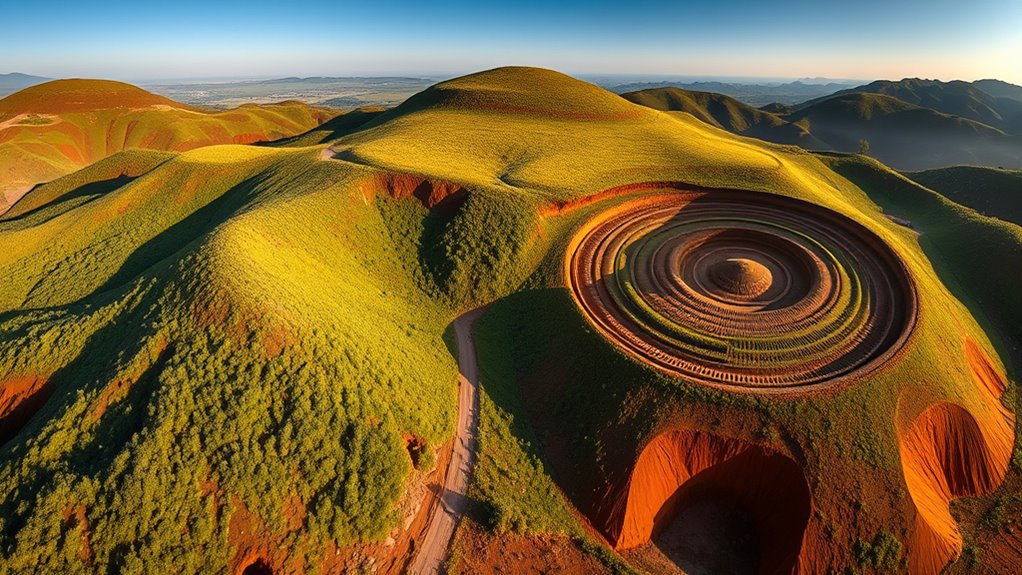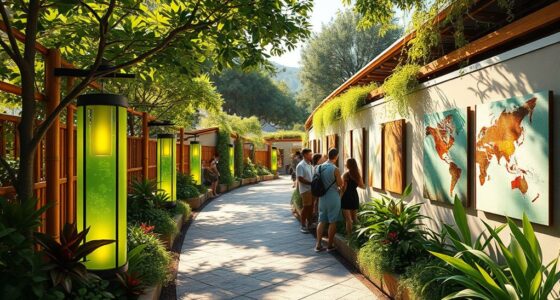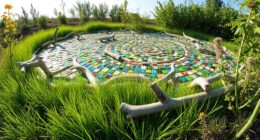Land art and earthworks involve transforming natural landscapes into large-scale, site-specific artworks by shaping and integrating with the environment. You see artists use minimal materials like earth, rocks, and plants to create sculptures that blend seamlessly with their surroundings. These works emphasize sustainability, reduce waste, and foster eco-awareness. If you’re curious about how artists actively work with nature’s features to craft meaningful experiences, there’s much more to explore beneath the surface.
Key Takeaways
- Land art transforms natural landscapes into large-scale, site-specific artworks by shaping and integrating with the environment.
- Artists use minimal materials like earth, rocks, and plants to create sustainable, eco-friendly art that reduces environmental impact.
- Techniques include working with existing topography, water flow, and natural features to enhance visual harmony.
- The art experience is designed to be contextual, encouraging viewers to engage with the landscape and reflect on ecological relationships.
- Land art emphasizes ecological consciousness, challenging traditional art norms while promoting environmental preservation through creative expression.

Land art and earthworks are innovative artistic practices that transform natural landscapes into large-scale, site-specific works. These creations go beyond traditional art forms, as you actively shape the environment itself rather than working within a gallery or studio. When you engage in land art, you’re working in harmony with the land, emphasizing nature integration by using the landscape’s natural features as part of your design. This approach allows you to create art that is deeply connected to its environment, encouraging viewers to see the land in new ways. It’s about more than just aesthetics; it’s about forging a relationship between the artwork and its setting, making the landscape an integral part of the piece.
Land art transforms landscapes into immersive, site-specific works that foster a deep connection between nature and creativity.
As you plan and execute earthworks, you’re also mindful of the environmental impact involved. Unlike conventional art, land art often involves minimal materials—sometimes just earth, rocks, or plants—reducing waste and artificial interference. Your goal is to leave as little footprint as possible, ensuring the landscape remains as untouched as it was before your intervention. This careful consideration helps to protect ecosystems and maintain the natural balance. When you choose to work with the land rather than against it, you’re promoting sustainable artistic practices that respect the environment. Many earthworks artists take this further by restoring or preserving natural features, reinforcing the idea that art can coexist with nature without damaging it.
In creating land art, you often work with the land’s existing contours, using natural slope, water flow, and topography to inform your design. This not only enhances the visual impact but also ensures your work blends seamlessly into the environment. You might carve into the earth, create large-scale geometric shapes, or arrange natural materials to evoke specific ideas or emotions. Because your work is site-specific, it invites viewers to experience it in a particular moment and place, emphasizing the unique qualities of each landscape. This deep integration with nature fosters a sense of stewardship and encourages viewers to reflect on their relationship with the environment. Incorporating environmental awareness into your practice ensures your art supports ecological sustainability and responsible land use.
Ultimately, land art and earthworks challenge you to rethink traditional notions of art by prioritizing nature integration and minimizing environmental impact. Your creations become a dialogue between the land and viewer, inspiring awareness of ecological issues while celebrating natural beauty. Through this practice, you demonstrate that art can be a powerful tool for environmental consciousness, transforming landscapes into living, breathing canvas that highlights the importance of preserving our planet.
Frequently Asked Questions
How Do Artists Choose Locations for Land Art Projects?
You choose locations for land art projects based on careful site selection, considering how well the landscape integrates with your vision. You look for sites with meaningful features, natural textures, or striking vistas that enhance the artwork. Factors like accessibility, environmental impact, and the relationship between the art and its surroundings guide your decision, ensuring your piece harmonizes with the landscape and creates a powerful, site-specific experience.
What Environmental Impacts Do Earthworks Typically Have?
Earthworks can cause environmental impacts like soil erosion and wildlife disruption. When you create these projects, you might disturb natural habitats, leading to displaced animals or plants. Additionally, moving or removing soil can increase erosion, affecting water quality and landscape stability. To minimize these impacts, you should plan carefully, use sustainable practices, and respect the natural environment, ensuring your art doesn’t cause long-term ecological harm.
Are Land Art Pieces Permanent or Temporary?
You might think land art pieces are here today, gone tomorrow, but some are designed for art preservation, lasting decades or even centuries. Others are meant for site transformation, existing temporarily to make a statement or highlight environmental concerns. Depending on the artist’s intent and environmental factors, these works can be permanent or temporary, showcasing nature’s ability to adapt or reclaim the space over time.
How Do Land Artists Fund Their Large-Scale Projects?
You fund your large-scale land art projects through a mix of grant funding and private sponsorships. Grants from arts organizations or government agencies provide essential financial support, while private sponsors offer additional resources or materials. You might also seek donations or collaborate with local communities to help cover costs. This combination helps you realize ambitious projects that require significant investment, ensuring your work can come to life in the landscape.
Can Land Art Be Considered Sustainable Art Practice?
You might see land art as a living canvas, and yes, it can be a sustainable practice when you minimize its ecological footprint. By choosing eco-friendly materials and respecting natural processes, you support art conservation and reduce harm to the environment. When thoughtfully executed, land art becomes a harmonious dance with nature, leaving a lasting impression without damaging the landscape, making it an enduring, sustainable art form.
Conclusion
As you explore land art and earthworks, you realize you’re truly shaping the landscape rather than just observing it. These masterpieces remind you that nature and human creativity can blend seamlessly, creating something timeless. Don’t forget, sometimes you have to get your hands dirty to see the beauty unfold. Embrace this harmony with the earth, and you’ll discover that true art is often found where the grass meets the sky, waiting for you to leave your mark.








